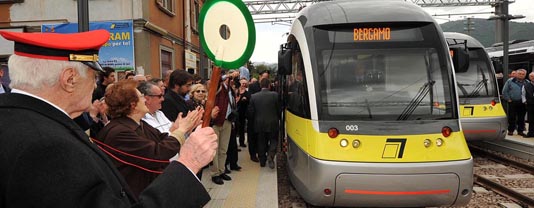Built mainly along the route of the disused Val Seriana railway line, it has quickly established itself as an efficient and highly popular transport system
It is now unanimously acclaimed as an example of excellence in the sector of local public transport in Italy. The Bergamo-Albino tramway which was officially opened four years ago, is proof that even in a medium sized city such as Bergamo, rail transport can have a key role in urban mobility. In the case of Bergamo, a city in Lombardy, around fifty kilometres north-east of Milan and home to 130,000 inhabitants, it is even more interesting because to build this line, the first of a larger network, the railbed of a local disused railway line, the ‘Ferrovia della Val Seriana’, was used. This railway line was closed in 1967, when mass motorization began to take over. Today the line, also known as the ‘Tram delle Valli’ (the Valley Tram), offers an urban service in the city of Bergamo with its first 6 stops and a suburban service to the Valle Seriana Inferiore, which in recent years has become a kind of linear city stretching down to Bergamo. We spoke to Mr Gianni Scarfone, engineer and managing director of TEB (Tramvie Elettriche Bergamasche – Bergamo Electric Tramways) and one of the leading experts in local public transport in Italy.
Railway Engineering: Mr Scarfone, the Bergamo-Albino Tramway is considered a case of excellence in the field of public transport in Italy. Why is that?
Gianni Scarfone: That’s true for a number of reasons: unfortunately Italy does not excel in local public transport, especially if we look at rail systems. It has to be said that in recent years we have seen some encouraging signs but we are without doubt still a long way behind the situations we see in other European countries like France, Germany and Switzerland, for example. Which is why the fact that TEB managed not only to build this engineering work, but also to obtain decidedly positive results, not only in terms of passenger numbers but also in the overall level of approval from the population, is so significant.
Full article is available only for registered users.
Click the link below to download pdf version of Railway Engineering
